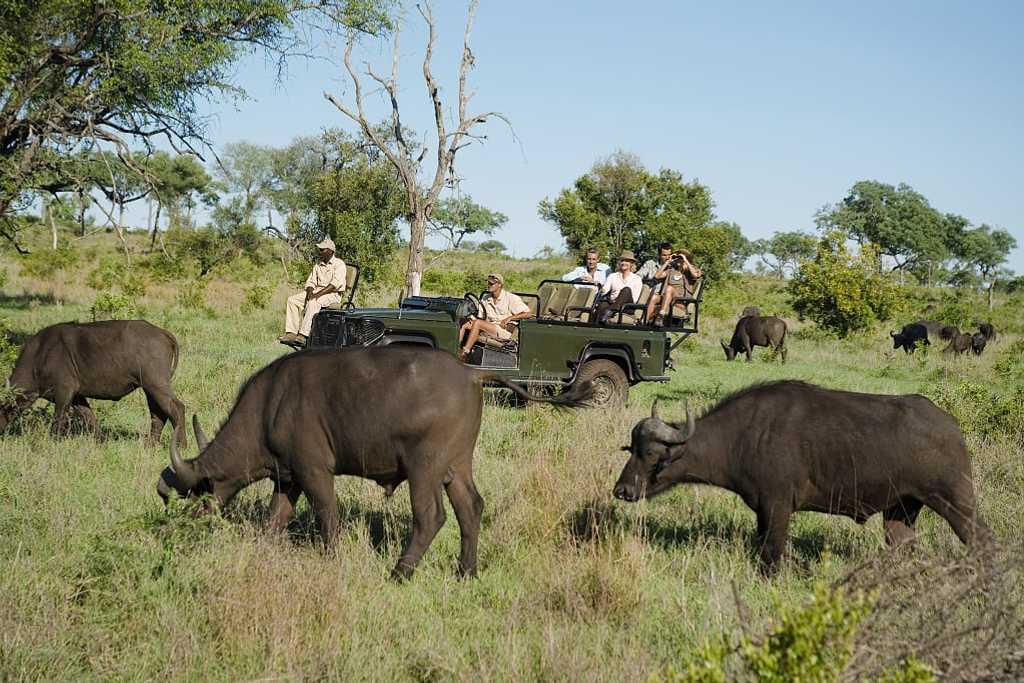What to Pack for an African Safari: 12 Tips as You Plan for Your Trip

Kruger National Park, South Africa
With your itinerary set and your tickets purchased, you may be wondering what to pack for an African safari. The following 12 tips will help answer some of those questions.
Questions such as how much luggage to take and what type of clothing and colors are appropriate for the bush? How much money will I need at the destination and what do I need to know about interacting with locals are just a few thoughts to work through as you prepare and pack.
Many online packing guides complicate matters with a seemingly endless list of “essential” items. This can be an issue when confronted with the luggage weight restrictions of light-aircraft flights to remote destinations or the logistical challenges of packing too much. Here is a simple guide on what and how to pack.
1. Just Get Started
Packing for a continent and experience you know little about can be daunting and begs the question, where to start?
Consider the number of days you will be on safari, whether you will be extending for a city or beach escape, and what essentials or comfort items you simply can’t go without. Lay it all out, then, one by one, decide if it is essential and start packing.
Learn more: How to Plan an African Safari: Frequently Asked Questions
2. Pack Light
This is a two-fold consideration as packing light can refer to the color and style of clothing and the number of items you bring. With a focus on color, preference should be given to tans, beiges, khakis, and other earthy tones as these blend well with the African bush.
Steer away from bright colors as reds and yellows make you stand out, especially on a walking safari. White also reflects and can make you uncomfortable under the hot sun. You will want to include short-sleeve shirts and capri pants or shorts, perhaps ones that can go from long to short with one unzip. Include a light jacket for cool, evening drives and early-morning winter starts. Depending on the time of year, a thin rain slicker can also be helpful.
One good pair of walking shoes will suffice and it does not hurt to throw in a scarf and gloves for those extra-cold drives. A sun hat is also essential, ideally one that can fold rather than be carried separately.
3. Consider Luggage Restrictions
Part of the thrill of safari is getting there and sometimes this requires taking a small aircraft. Luggage restrictions should be considered from the start because while your international flight will allow larger bags, your domestic flights within Africa may not.
Lodge hopping is popular on many safari circuits and with a baggage allowance of around 32lbs, inclusive of hand luggage in most cases, it is essential to pack as light as you can.
While some exceptions for weight may be made, there are strict rules for the style or type of baggage that will be accepted. The aircraft hold is small and only accommodates soft-sided bags, so duffel bags are often the best choice. Porters and assistants throughout your adventure will be on hand to assist, adding that extra bit of comfort to your experience.
4. Consider Your Destinations
Packing may come down to what it is you plan to experience.
If you intend to simply spend a few days in the African bush, perhaps moving from lodge to lodge or enjoying one reserve, light luggage will suffice. If combining more of your surroundings, you may need a little more room. Many ground handlers in Africa will offer to store oversized luggage in their hubs while transferring your belongings to smaller bags for your safari.
Conveniently, most lodges provide a laundry service, so keeping things to a minimum is possible, no matter where your journey takes you.
Learn more: Types of Safari Accommodations and How to Choose • Types of African Safaris: Different Ways to Experience a Safari
5. Pack for a Purpose
We all know that going on safari fills your soul and leaves you feeling enriched and enlightened. There is the opportunity to take that joy to the next level by giving back, and this comes in many forms.
Safari properties often work with organizations and communities on well-thought-out projects and can provide lists of specific needs for travelers looking to support local communities.
Some pre-requested items can be brought from home or you can purchase supplies locally. When planning your safari, just ask your Zicasso travel expert and they will provide the relevant information.
6. Take an Extra, Small Bag Along for Souvenir Shopping
If weight is not restricted by small aircraft or you are able to store larger items at hubs at your destination, consider taking an extra hand-luggage bag for souvenirs.
Stops at local trading stalls or markets are always offered on an African safari itinerary, providing the opportunity to purchase exquisitely-crafted souvenirs. Some can be shipped home, while others are carefully wrapped and can be carried up front with you on your flight home.
7. Leave Non-essential Items Behind
Some travelers feel comfortable taking items such as hair straighteners, hair dryers, or traveling irons with them on safari. Voltage in the USA is 110v, while in Africa it is 220v-240v, so these items will not work at your destination.
Definitely bring your camera, charger, and spare batteries as these all run on 110v to 240v, so can be charged without a converter.
Looking pretty in the bush is your prerogative. However, it is advisable to leave your favorite jewelry behind and not carry too much cash. Speak to your Zicasso safari expert regarding the appropriate amount of money for tipping or souvenirs, and opt to bring a maximum of two credit cards with you.
8. Pack Important Medications
It is advisable to keep your medications in their original packaging and to carry these in your hand luggage. Take your prescription with you too and keep a list of instructions you may require regarding storing your medication or what to do in a medical emergency pertaining to your medical needs.
Be sure to note any restrictions in the country you are traveling to and leave any non-welcome or unnecessary pills behind as certain medications may not be permissible within the country’s borders, even with a prescription.
9. Consider Using Packing Cubes
With a strict ban on plastic bags in most African countries, it is important your toiletries, medicines, and walking shoes are packed in packing cubes.
There are many options these days, ranging from soft to hard, small to large, and in an array of colors, offering practicality and ease of use as you travel between reserves and lodges.
10. Don’t Worry About Forgetting Things
Most safari itineraries will involve a layover in an African entry city, a good place to stock up on anything you may be missing. If time does not allow for a quick stop, take comfort in knowing that most lodges and tented camps will have a small shop that will hold key items such as shampoo, toothpaste, sunscreen, sunglasses, or toothbrushes.
Depending on where you go on your safari, the city may also be where you will meet up with your guide, an ideal time to learn a bit more about your destination.
11. Share Your Itinerary With a Friend or Family Member Back Home
Leaving a copy of your itinerary with a friend or family member back home will most likely make them a little jealous, but the main purpose is to let them know where you will be on your journey.
Life happens. Often cell phones don’t work in the bush and being able to get in touch with you could be essential. Your loved one may also want to surprise you with a gesture that can be arranged with the lodge or camp staff should you be celebrating a special occasion.
12. Learn About Your Destination
Embarking on an African safari is exciting, partly because you are heading into a land and culture quite different from your own. Having an understanding of traditions and customs is important, and it is a good idea to have an idea of how life works inside and outside your safari circuit.
Your interactions with locals will be unique and memorable to you, and your game drives will deliver thrilling wildlife interactions. However, being knowledgeable about the country, your accommodations, and wildlife ethos will enhance your overall experience.
Learn a few local words because this is sure to impress your guides and lodge staff, making you feel like one of the family.
Learn more: Best Places to Visit in African on Safari • Best African Safari Countries and Where to Go Within Them
What to Bring on an African Safari: Your Simple Packing List
For a snapshot of what you should bring, the following is considered a standard list for anyone going on an African safari.
- High-SPF sunscreen
- Sunhat or baseball cap
- Comfortable lightweight clothes of neutral colors, including t-shirts, jeans, khaki or linen pants, lightweight long-sleeve shirts, bathing suits, personal garments, etc
- Avoid camouflage or military-inspired clothing
- Comfortable closed shoes
- Good walking shoes are ideal, while boots are not necessary
- First aid and toiletries
- A light fleece or sweater for the evenings
- Insect repellent
- Scarf, gloves, and beanie for cold mornings
- Camera and binoculars
- Essential medications
- Books, card games, or other leisure activities
- Your Zicasso safari specialist will provide a list of necessary vaccinations, passport information, recommended travel insurance, credit cards, cash, and more
The packing guideline is simple and hopefully it’s a relief to discover you need a lot less than you thought. Remember, while you are heading into the wilderness, you are on a fully-guided tour and everyday essentials can be sourced. If it rains you will be covered as lodges and camps plan for the occasional downpour and provide ponchos and umbrellas.
Your camps and lodges also provide insect repellent and some offer sunscreen. Hairdryers can be requested and it is important to note that voltage in Africa differs from that in North America, so leave your favorite styling electronics at home. From luxury toiletries to slippers, gowns, and personalized water bottles, depending on where you stay, you will want for nothing.
Your Safari Specialist is Ready to Help

Serengeti, Tanzania
A safari is an experience you should enjoy at least once in your life and with the right information at hand, packing for it should be exciting and stress-free.
Learn more about what to expect on your trip with our Africa safari guide or explore featured itineraries with our African safaris sample trips that can help demonstrate what you can experience during a custom-tailored tour from Tanzania to South Africa, Botswana to Uganda.
Life-Enriching Travel Designed Just for You
- 1
Trips curated by the world’s top destination experts
- 2
Concierge-level service leading up to and during your trip
- 3
Unique, exclusive experiences and insider access

